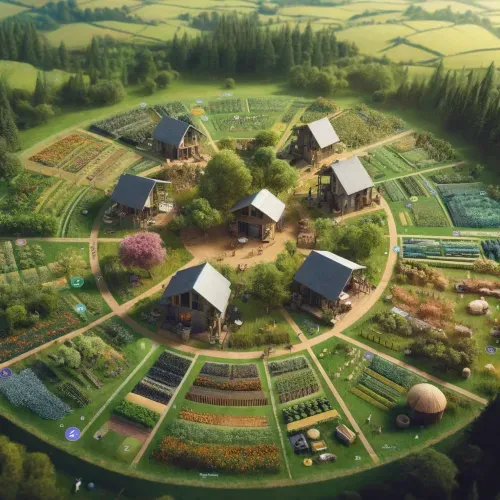Join a permaculture community
The world is quickly realizing that the centralized systems created during the rise of the industrial and information age are fragile. In the face of a barrage of external threats, people have turned to seeking alternative systems of living that better provide security and a high quality of life. Permaculture is one of these systems and joining a permaculture community might be your best bet for your family and friends t0 thrive for generations to come.

What is a permaculture community?
To start, what is permaculture?
“Permaculture is a philosophy of working with, rather than against nature; of protracted and thoughtful observation rather than protracted and thoughtless labor; and of looking at plants and animals in all their functions, rather than treating any area as a single product system.”
— Bill Mollison
Permaculture itself is a design system and philosophy of life born out of the minds of Bill Mollison and David Homgren in the 1970s. Bill and David developed a comprehensive core set of ethics and principles for which built environments can be based on.
The core ethics are:
- "Care of the Earth: Provision for all life systems to continue and multiply"
- "Care of people: Provision for people to access those resources necessary for their existence"
- "Set limits to consumption and reproduction, and redistribute surplus: By governing our own needs, we can set resources aside to further the above principles"
The core principles are:
- 1. Observe and Interact - By taking the time to engage with nature we can design solutions that suit our particular situation.
- 2. Catch and Store Energy - By developing systems that collect resources when they are abundant, we can use them in times of need.
- 3. Obtain a Yield - Ensure that you are getting truly useful rewards as part of the work that you are doing.
- 4. Apply Self-Regulation and Accept Feedback - We need to discourage inappropriate activity to ensure that systems can continue to function well.
- 5. Use and Value Renewable Resources and Services - Make the best use of nature's abundance to reduce our consumptive behavior and dependence on non-renewable resources.
- 6. Produce No Waste - By valuing and making use of all the resources that are available to us, nothing goes to waste.
- 7. Design From Patterns to Details - By stepping back, we can observe patterns in nature and society. These can form the backbone of our designs, with the details filled in as we go. Sometimes this is also called biomimicry.
- 8. Integrate Rather Than Segregate - By putting the right things in the right place, relationships develop between those things and they work together to support each other.
- 9. Use Small and Slow Solutions - Small and slow systems are easier to maintain than big ones, making better use of local resources and producing more sustainable outcomes.
- 10. Use and Value Diversity - Diversity reduces vulnerability to a variety of threats and takes advantage of the unique nature of the environment in which it resides.
- 11. Use Edges and Value the Marginal - The interface between things is where the most interesting events take place. These are often the most valuable, diverse, and productive elements in the system.
- 12. Creatively Use and Respond to Change - We can have a positive impact on inevitable change by carefully observing and then intervening at the right time.
A Permaculture community is housing designed and developed with these principles in mind. In addition to these principles, in permaculture design there are zones that exist in a circular layout. From the inner circle to the outer circle, the zones are:
Zone 0: The Home (Center): This is the central hub for all human activity and includes the dwelling units. The zone is characterized by high human interaction and intensive human management.
Zone 1: Immediate Surroundings: This zone comprises that which requires daily attention and maintenance. Herb gardens, vegetable crops that are frequently harvested, kitchen compost and/or worm farms, and soft fruits are examples of products found in zone 1.
Zone 2: Is less intensively managed. small orchards, larger-scale food production, and small-livestock reside in this zone. That which is used less and is more self-sustaining than zone 1. Examples of products are beehives, chickens, and fruit trees. Zone 2 is fully-irrigated.
Zone 3: is a bit more self-managed with dry crops like grains and legumes, grazing for livestock, and nut trees. Typically this zone is visited once a week or less.
Zone 4: Is semi-wild- Where the native edible food forest provides wild foods and firewood. This can be seen as a buffer between wilderness and cultivated land.
Zone 5: Wilderness: Unmanaged land that requires no intervention. This zone is recreational and should not be harvested or managed once established.
You can imagine in a permaculture community how the layout might look. A collection of homes near the center of the property with personal gardens all around and gradually expanding into native wilderness.
Where can I join a permaculture community today?
While it is difficult to find communities that are fully dedicated to permaculture, there are several sites that can help you find a permaculture community.
- Global Ecovillage Network- A platform to connect people interested in ecovillages with ecovillages that meet their criteria for a community. Not all, but many of these ecovillages will have been designed with Permaculture in mind.
- Permaculture Global- This platform is specifically around building permaculture community and contains a wide-variety of permaculture related projects, courses, and fellow enthusiasts.
- WWOOF- Working Weekends on Organic Farms was created to reconnect city people with agriculture. Again, not all of these will follow permaculture principles and most are for more temporary stays, but this is still a good way to find people that are listing permaculture in their profiles and asking them about their specific setup
- IC.org- Offers resources and listings for intentional communities, including eco-villages, co-housing, and cooperative living arrangements across the globe. You will find that some listings are living in a permaculture community.
- Permaculture Research Institute- Provides education, research, and information about permaculture, with a focus on sustainable living and design. A good online permaculture community to get you looped in.
Why are there not more examples of permaculture communities?
Despite the appeal of the permaculture communities as a way to reconnect with the earth and live in a manner more sustainable than modern society, especially with younger generations, there are many challenges in effectively making permaculture communities the prevailing model for living. Here are a few reasons why they are not more prevalent:
- Financial constraints: Acquiring land for such projects is a big barrier to entry. Currently, land developers have little incentive to build new housing developments with permaculture in mind because there is no “pro-forma” for creating profitable permaculture communities. While the economic benefits in the long-run are quite clear, current methods of development (clear cutting, trucking off top-soil, and paving) are cheaper and the demand for such housing is known.
- Regulation and zoning: Especially in the United States, zoning laws in rural areas are quite strict about development. Land is often zoned for one house every 1-5 acres in the county to “keep rural areas rural”. As cities and towns expand, they upzone farm and rural lands to be developed for density and do not preserve the natural landscapes or biodiversity.
- Lack of awareness: The general public has not demanded developers to offer permaculture housing communities. This is of course difficult to ask of consumers because they need housing for their families and often do not have a choice while they seek affordable options near where they work. This is one reason The Sunflower Collective exists- to prove to developers that there is in fact demand. We aim to create the largest permaculture community on planet earth.
Of course, if you don’t find what you are looking for…
How can I start a permaculture community?
Should you not find your permaculture community for one reason or another, here are the steps to start your own:
- Education and Training: Gain a solid understanding of permaculture principles through courses, workshops, and self-study. Consider completing a Permaculture Design Certificate (PDC), which is widely recognized in the permaculture community. And definitely buy the big book, Bill Mollison’s, “An Introduction to Permaculture”.
- Vision and Goals: Develop a clear vision and set of goals for your permaculture community. What are the core values? What do you hope to achieve environmentally, socially, and economically?
- Gathering a Group: Build a group of like-minded individuals who are committed to the vision. This group will form the core of your permaculture community, so it’s crucial that members share similar values and goals.
- Land Acquisition: Secure land suitable for permaculture practices. Consider factors like soil fertility, water availability, climate, and existing infrastructure. This step often requires significant financial resources.
- Legal Structure: Decide on a legal structure for the permaculture community (e.g., cooperative, nonprofit, collective). This will impact governance, finances, and legal responsibilities.
- Design and Planning: Use permaculture design principles to plan the layout and functioning of the permaculture community. This includes the placement of buildings, water systems, gardens, and common areas. It’s helpful to involve an experienced permaculture designer.
- Infrastructure Development: Develop the necessary infrastructure for living and farming, such as water systems, renewable energy installations, and housing. This phase can be phased in as resources allow.
- Permaculture Community Governance: Establish governance structures and decision-making processes. Many permaculture communities use consensus-based approaches or sociocratic methods to ensure that all members have a voice.
- Sustainable Practices: Implement sustainable agricultural practices based on permaculture principles. Start small, learn from the land, and expand as you gain experience.
- Permaculture Community Building: Develop programs and activities that strengthen community bonds, such as shared meals, educational workshops, and social events.
- Outreach and Networking: Connect with other permaculture and ecological communities for support, learning, and sharing of resources. This can also involve engaging with the local community to promote sustainable practices.
- Continuous Learning and Adaptation: Be prepared to adapt and evolve as you learn from your experiences. Permaculture is about continuous learning from the environment and community interactions.
Or, join us! We are building communities on small-scale farms with permaculture principles in mind.
Sign-Up here to receive updates on our progress and express interest in the project. This helps show farmers and investors around the world that people want to live in community on a farm.
